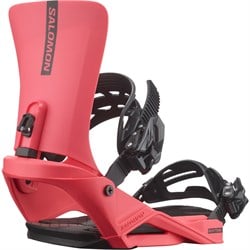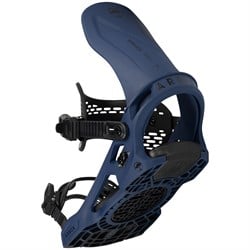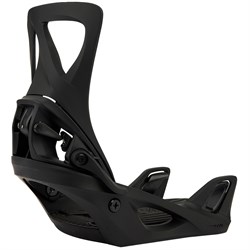How to Choose Snowboard Bindings & Compatibility Guide
Bindings are your direct connection to your snowboard and transfer your energy, so getting a pair that works for your riding style and ability level is important. It ultimately comes down to preference, but it's important to consider the flex, type of binding, and compatibility with your board when choosing your snowboard bindings so you can have the best experience on the mountain.
Contents
Riding Style and Flex
Your ability and riding style will help determine what flex binding will work best for you. The flex is usually rated on a scale of 1-10 or 1-5, with lower numbers indicating softer flexes.
Binding flex mostly depends on personal preference, but there are a few helpful guidelines to get you started.
If you're a newer rider or spend a lot of time in the park, you'll likely prefer a softer, more forgiving binding. On the other hand, more advanced and freeride-oriented riders often prefer bindings that are stiffer and more responsive at speed. Most people will fall somewhere in the middle, though, with medium flex bindings that offer balanced all-mountain performance.
You should also consider the flex of your boot when choosing a snowboard binding. Soft boots and stiff bindings will work against each other, so try to find boots and bindings with similar flexes.
Types of Snowboard Bindings
Parts of Snowboard Bindings
Snowboard bindings consist of multiple components:
Straps
Toe Cap Strap
This strap sits on the front of the boot, wrapping over the toe box for comfortable and stable positioning. This strap helps align the foot for better placement in the heel cup, ultimately giving more response to the board.Traditional Toe Strap
This strap is usually on lower-end bindings and holds your boot in place by passing over the top of the toe area. It cannot be used as a toe cap strap.Hybrid Toe Strap
This strap is usable in either a traditional style over the foot or tilted forward for use like a toe cap strap.Ankle Strap
Securely wrapping above the ankle, this strap is larger; without it, the bindings would fail.One Piece
Most common on rear entry and youth bindings, this is one giant strap that covers your boot from right before your ankle to just before your toes.*Of note, step on bindings will not have straps.
Highbacks
- A highback is a vertical plate from the heel cup to the lower calf
- It controls the heelside edge of your board.
- Stiff and tall highbacks are intended for enhanced control and speed.
- Soft and shorter highbacks are intended for park riders and beginners looking for flexibility and ease.
- Forward lean adjustments on highbacks enable you to easily adjust your binding positioning on the go for placement preferences.
- Bindings with no backs provide a more skate-like feel, allowing for more mobility in the ankle and looser control of your board.
Baseplate
- This is the primary connection between the binding and the board.
- Baseplates are made with a variety of materials that feature different strength-to-flex ratios. Higher-end bindings will have more robust baseplate materials and optimize board flex, power transmission, and durability.
- Cushioning on baseplates allows for comfort and power transmission.
- Canting - A small amount of tilt in the footbed ergonomically angles your stance and knee position slightly forward for a more natural stance.
Snowboard Boot & Binding Compatibility
How Should Snowboard Bindings Fit My Boots?
Snowboard bindings come in general sizes that range from S to XL. It is essential to have the right size bindings for your boots, so always check out the manufacturer’s binding size chart on individual product pages to see what size binding you need.After consulting the manufacturer’s size chart, it is critical to check that the binding fits your boots. Do this by placing your boot in your binding as if you were to strap in; the boots shouldn’t hang excessively off the bindings, nor should the straps be painfully tightened or have excess slack. If the strap ladder does not reach the ratchet, it may need to be adjusted - binding straps typically adjust from both sides to center the strap over your boot.
The heel should fit snugly in the binding. A properly fit binding should allow the boot to flex, but not sway. If you have comfortable boots, and the bindings securely grip your boots with no extra play, then you have a good match.
Binding Compatibility with Snowboards
Just like snowboards, bindings come with different options for mounting. There are a variety of mounting options and hole patterns on snowboards, and the binding's mounting disc holes have to align. In general, most binding discs are compatible with most mount patterns, but it's good to make sure. Luckily, most brands nowadays have "universal discs" or offer multiple discs to cover different types of mounting holes. Double-check the Binding Mount Pattern spec or reach out to our Customer Care team to ensure that the binding will be compatible with your snowboard.Snowboard Mounting Patterns
There are three different snowboard hole patterns that you will find on conventional snowboards. The patterns include 2x4, 4x4, and The Channel™. Channel technology was originally specific to Burton Snowboards, although some board makers have begun licensing Channel technology from Burton. 2x4 is a variation of 4x4 that gives the rider more mounting options.
The Snowboard Binding Channel System
Chances are if you've spent time around snowboards, you've seen the channel system. This unique system can be found on all modern Burton snowboards and several other snowboard brands. It offers a variety of stance variations and options. Understanding the ins and outs of this system is key to getting the most out of your gear and finding a setup that works well together.
What is The Channel System
The actual Channel System refers to the two integrated slots that run parallel to the edge of the board and are the system used to attach your bindings to your snowboard. Allowing for a full range of customizable stances the Channel system allows you to slide your bindings down the length of the entirety of the snowboard.
Channel System Binding Compatibility
These days, most binding companies have made their products compatible with the Channel system. Looking for bindings that say they are either Channel compatible, Re:Flex™ compatible or offer a universal mount disc are going to get you what you need.Be aware that some binding companies only make their higher priced bindings compatible with the Channel system. Generally, these companies sell a universal disc that you can purchase separately. Always ask if you are unsure if the bindings you're looking at are right for your set up.
Oh, and a friendly reminder... ALL Burton bindings will work on Burton snowboards.
How to Mount Your Snowboard Bindings
Now that you've chosen your next set of bindings, head over to our How to Set Up Snowboard Bindings guide to get your equipment put together and dialed.
Still have questions?
Reach out to our Customer Care team with any questions! We'd love to help you narrow down our wide selection of snowboard bindings and ensure that your snowboard gear will all be compatible together.Learn More With Our Other Snowboard Guides:
Snowboards - Snowboard Rocker Explained
Snowboards - Kids' Snowboards Size Chart
Snowboards - How to Choose a Freestyle Park Setup
Snowboards - How to Choose Snowboard Shapes
Asymmetrical Snowboard Shapes Guide
Snowboard Boots - How to Choose & Fit Guide
Snowboard Boots - How to Put on & Fit
Snowboard Bindings - How to Choose & Compatibility Guide
Snowboard Bindings – How To Set Up
How to Wax a Snowboard
Socks - How to Choose Snowboard Socks
Gloves & Mittens - How to Choose
Goggles - How to Choose
Goggles - Wearing Goggles with Glasses
Helmets - How to Choose & Fit Guide
Outerwear - What to Wear Snowboarding
Outerwear - How to Wash Waterproof Jackets & Clothing
Outerwear - Regional Snowboard Guide
Snowboard Socks - Sizing & Buyer's Guide
Snowboarding - How to Get in Shape
Travel - How to Fly with Snowboards
Splitboarding - Board and Binding Weight Chart
Avalanche Probes - How to Choose
Backcountry - Choosing an Avalanche Airbag Pack
Backcountry - Choosing an Avalanche Beacon
Backcountry - Climbing Skins Size Guide
Backcountry - How to Choose an Avalanche Shovel
Backcountry - How to Choose Climbing Skins
Backcountry Backpacks - How to Choose
Backcountry Basics - How to Get Started
Discover Our Favorite Gear:
The Best Women's Snowboards
The Best All Mountain Snowboards
The Best Directional Snowboards
The Best Powder Snowboards
The Best Park Snowboards
The Best Splitboards
The Best Freeride & Big Mountain Snowboards
The Best Beginner Snowboards
The Best Value Snowboards
The Best Carving Snowboards
The Best Men's Snowboard Boots
The Best Women's Snowboard Boots
The Best Snowboard Bindings
The Best Splitboard Bindings
The Best Snowboard Step On Bindings & Boots
The Best Kids' Snowboards
The Best Beginner Snowboard Boots
The Best Kids' Snowboard Boots
Popular Snowboard Searches
This is evo. We are a ski, snowboard, wake, skate, bike, surf, camp, and clothing online retailer with physical stores in Seattle, Portland, Denver, Salt Lake City, Whistler, and Snoqualmie Pass. Our goal is to provide you with great information to make both your purchase and upkeep easy.
evo also likes to travel to remote places across the globe in search of world-class powder turns, epic waves, or legendary mountain biking locations through evoTrip Adventure Travel Trips. Or, if you prefer to travel on your own, check out our ski & snowboard resort travel guides and mountain bike trail guides.
Still have questions? Please call our customer care team at 1.866.386.1590 during Customer Care Hours. They can help you find the right setup to fit your needs.




























